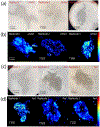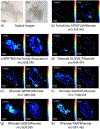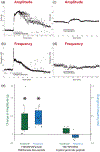Mass Spectrometry Quantification, Localization, and Discovery of Feeding-Related Neuropeptides in Cancer borealis
- PMID: 33522802
- PMCID: PMC7906219
- DOI: 10.1021/acschemneuro.1c00007
Mass Spectrometry Quantification, Localization, and Discovery of Feeding-Related Neuropeptides in Cancer borealis
Abstract
The crab Cancer borealis nervous system is an important model for understanding neural circuit dynamics and modulation, but the identity of neuromodulatory substances and their influence on circuit dynamics in this system remains incomplete, particularly with respect to behavioral state-dependent modulation. Therefore, we used a multifaceted mass spectrometry (MS) method to identify neuropeptides that differentiate the unfed and fed states. Duplex stable isotope labeling revealed that the abundance of 80 of 278 identified neuropeptides was distinct in ganglia and/or neurohemal tissue from fed vs unfed animals. MS imaging revealed that an additional 7 and 11 neuropeptides exhibited altered spatial distributions in the brain and the neuroendocrine pericardial organs (POs), respectively, during these two feeding states. Furthermore, de novo sequencing yielded 69 newly identified putative neuropeptides that may influence feeding state-related neuromodulation. Two of these latter neuropeptides were determined to be upregulated in PO tissue from fed crabs, and one of these two peptides influenced heartbeat in ex vivo preparations. Overall, the results presented here identify a cohort of neuropeptides that are poised to influence feeding-related behaviors, providing valuable opportunities for future functional studies.
Keywords: Mass spectrometry; cardiac neuromodulation; imaging; neuropeptides; stable isotope labeling; stomatogastric nervous system.
Conflict of interest statement
Competing Interests
The authors declare no competing interests.
Figures







Similar articles
-
Mass spectrometry profiling and quantitation of changes in circulating hormones secreted over time in Cancer borealis hemolymph due to feeding behavior.Anal Bioanal Chem. 2022 Jan;414(1):533-543. doi: 10.1007/s00216-021-03479-1. Epub 2021 Jun 29. Anal Bioanal Chem. 2022. PMID: 34184104 Free PMC article.
-
Feeding state-dependent modulation of feeding-related motor patterns.J Neurophysiol. 2021 Dec 1;126(6):1903-1924. doi: 10.1152/jn.00387.2021. Epub 2021 Oct 20. J Neurophysiol. 2021. PMID: 34669505 Free PMC article.
-
Mass spectrometric investigation of the neuropeptide complement and release in the pericardial organs of the crab, Cancer borealis.J Neurochem. 2003 Nov;87(3):642-56. doi: 10.1046/j.1471-4159.2003.02031.x. J Neurochem. 2003. PMID: 14535947
-
Neuropeptides in the crayfish stomatogastric nervous system.Microsc Res Tech. 2003 Feb 15;60(3):302-12. doi: 10.1002/jemt.10269. Microsc Res Tech. 2003. PMID: 12539160 Review.
-
Discovering new invertebrate neuropeptides using mass spectrometry.Mass Spectrom Rev. 2006 Jan-Feb;25(1):77-98. doi: 10.1002/mas.20055. Mass Spectrom Rev. 2006. PMID: 15937922 Review.
Cited by
-
Mass spectrometry profiling and quantitation of changes in circulating hormones secreted over time in Cancer borealis hemolymph due to feeding behavior.Anal Bioanal Chem. 2022 Jan;414(1):533-543. doi: 10.1007/s00216-021-03479-1. Epub 2021 Jun 29. Anal Bioanal Chem. 2022. PMID: 34184104 Free PMC article.
-
Cholecystokinin/sulfakinin peptide signaling: conserved roles at the intersection between feeding, mating and aggression.Cell Mol Life Sci. 2022 Mar 14;79(3):188. doi: 10.1007/s00018-022-04214-4. Cell Mol Life Sci. 2022. PMID: 35286508 Free PMC article. Review.
-
Time-Lapse Acquisition of Both Freely Secreted Proteome and Exosome Encapsulated Proteome in Live Organoids' Microenvironment.Adv Sci (Weinh). 2025 Jan;12(2):e2406509. doi: 10.1002/advs.202406509. Epub 2024 Nov 21. Adv Sci (Weinh). 2025. PMID: 39573935 Free PMC article.
-
Integrating intracellular and extracellular proteomic profiling for in-depth investigations of cellular communication in a model of prostate cancer.Proteomics. 2023 Nov;23(21-22):e2200287. doi: 10.1002/pmic.202200287. Epub 2023 May 24. Proteomics. 2023. PMID: 37226375 Free PMC article.
-
Unveiling the Impact of Rapeseed Meal on Feeding Behavior and Anorexigenic Endocrine in Litopenaeus vannamei.Animals (Basel). 2024 Feb 6;14(4):540. doi: 10.3390/ani14040540. Animals (Basel). 2024. PMID: 38396508 Free PMC article.
References
-
- Hulse BK, Jayaraman V Mechanisms underlying the neural computation of head direction. Annu Rev Neurosci 2019, 43, 31–54. - PubMed
Publication types
MeSH terms
Substances
Grants and funding
LinkOut - more resources
Full Text Sources
Other Literature Sources

